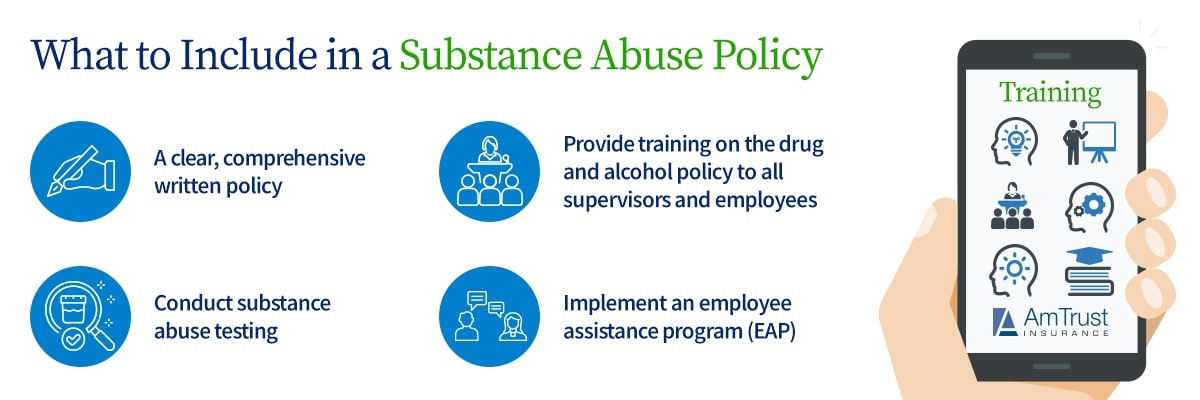Summary: Employees under the influence of drugs and alcohol endanger themselves and others and can become a hazard at the workplace. Learn why employers need to create a substance abuse policy, what the policy should include, and how to best implement it to help reduce substance abuse in the workplace. The Importance of a Drug-Free Workplace
Employees engage in a variety of daily tasks which they need to be mentally alert for at all times. Those using heavy equipment, handling materials or driving vehicles come to mind first. However, even workers completing menial tasks must be aware of their surroundings to do their jobs successfully. Employees should be of sound mind when they report to work each day, and workers under the influence of alcohol, illegal and even legal drugs (such as over-the-counter cold medications that may cause drowsiness), are not fully alert. They endanger not only themselves but also their coworkers, customers, and others who simply may be nearby.
The National Safety Council (NSC) states that workers with substance abuse disorders miss
two more weeks of work annually compared to their peers, averaging almost five weeks of missed work a year. The majority of these missed days of work are due to illness or injury. Employers also face implications other than safety factors. For instance, there may be additional costs for retraining new employees in the missing worker’s absence, decreased or lost productivity, and higher healthcare rates to treat the conditions associated with substance abuse.
According to the
OSHA Safety and Health Administration (OSHA) General Duty Clause, employers must provide a safe workplace free from recognized hazards that could cause serious physical harm, or even death, to their employees. Employees under the influence could compromise themselves and others, and drugs and alcohol are recognized workplace hazards.
Substance Abuse in the Workplace

Millions of Americans face substance abuse disorders, misusing drugs or alcohol. In fact, the U.S. Department of Health and Human Services reported that 46.3 million individuals aged 12 or older had a substance abuse disorder in 2021, with the usage highest among those aged 18 to 25. Alcohol, prescription pain medications and opioids are among the most commonly-used substances with over 2 million Americans suffering from opioid addiction.
Related content: Read how AmTrust drastically cuts the percentage of claims with opioids by 75% to improve chronic pain outcomes and reduce dangerous prescriptions in the AmTrust Opioid Risk Report.
According to research organization NORC at the University of Chicago, certain industries have higher rates of employees with alcohol and drug abuse disorders, such as construction, mining and service occupations. However, even in industries with lower rates, such as education, healthcare and professional services, one worker in 12 has a substance abuse disorder. And employees who use drugs or alcohol on the job are more likely to be involved in workplace accidents that result in a workers’ compensation claim.
Creating a Drug and Alcohol Policy
To ensure worker health and safety, it’s imperative that employers create a drug and alcohol policy to help not only prevent accidents and injuries, but also to identify workers who may have a problem and help protect their workforce.
To develop a drug and alcohol policy for the workplace, it’s recommended that business owners first contact their attorneys for information related to state-specific laws and requirements. A lawyer can help employers draft and implement a substance abuse policy that best protects the business and the workers.
The Substance Abuse and Mental Health Services Administration (SAMHSA) states that the
drug-free workplace policy should include the company’s statement of purpose and how the policy will be implemented. It’s the employer’s choice if the policy only touches on the minimum requirements by law or if it should be expanded to include other issues that arise from worker substance abuse, such as missing work and lost productivity.
What to Include in a Substance Abuse Policy

The basics of a workplace substance abuse policy include the following:
A clear, comprehensive written policy
After consulting their attorney, an employer can also consider involving employees in drafting the drug and alcohol policy. Employees may have valuable input to contribute. The policy should clearly communicate to employees why the policy has been implemented, specifically state which behaviors are prohibited, such as using illegal drugs on the job, operating machinery or vehicle while under the influence of drugs or alcohol, and outline the consequences for employees who violate the policy.
Provide training on the drug and alcohol policy to all supervisors and employees
Supervisors should be trained to recognize the signs of an employee under the influence of drugs or alcohol. They should also understand the elements of the substance abuse policy and how to strictly enforce it. Employees also need training on the policy details and should know that substance abuse will not be tolerated. All staff, including new hires, should be provided copies of the policy.
Conduct substance abuse testing
Owners should consult an attorney to learn about any applicable laws before conducting regular testing. But drug abuse testing can help identify workers with potential problems and also help to deter them from using drugs or alcohol at the workplace. Only trained professionals should conduct the testing.
Implement an employee assistance program (EAP)
Consider looking into an outside organization to help create an employee assistance program, or EAP. Many employees who might be dealing with daily stress could benefit from a program like this, which offers counseling services that could help them avoid resorting to drugs or alcohol.

Safety Resources from the AmTrust Loss Control Department
The AmTrust
Loss Control department specializes in risk management solutions to prevent injuries and improve employee safety. We help businesses take a proactive approach to reducing workplace accidents, identifying specific hazards and offering solutions that fit the organization’s specific needs. We even offer
Virtual+ Loss Control services, leveraging mobile technology to perform worksite inspections and tour policyholders’ facilities remotely in real time. To learn more about our loss control services, please
contact us today.
This material is for informational purposes only and is not legal or business advice. Neither AmTrust Financial Services, Inc. nor any of its subsidiaries or affiliates represents or warrants that the information contained herein is appropriate or suitable for any specific business or legal purpose. Readers seeking resolution of specific questions should consult their business and/or legal advisors. Coverages may vary by location. Contact your local RSM for more information.